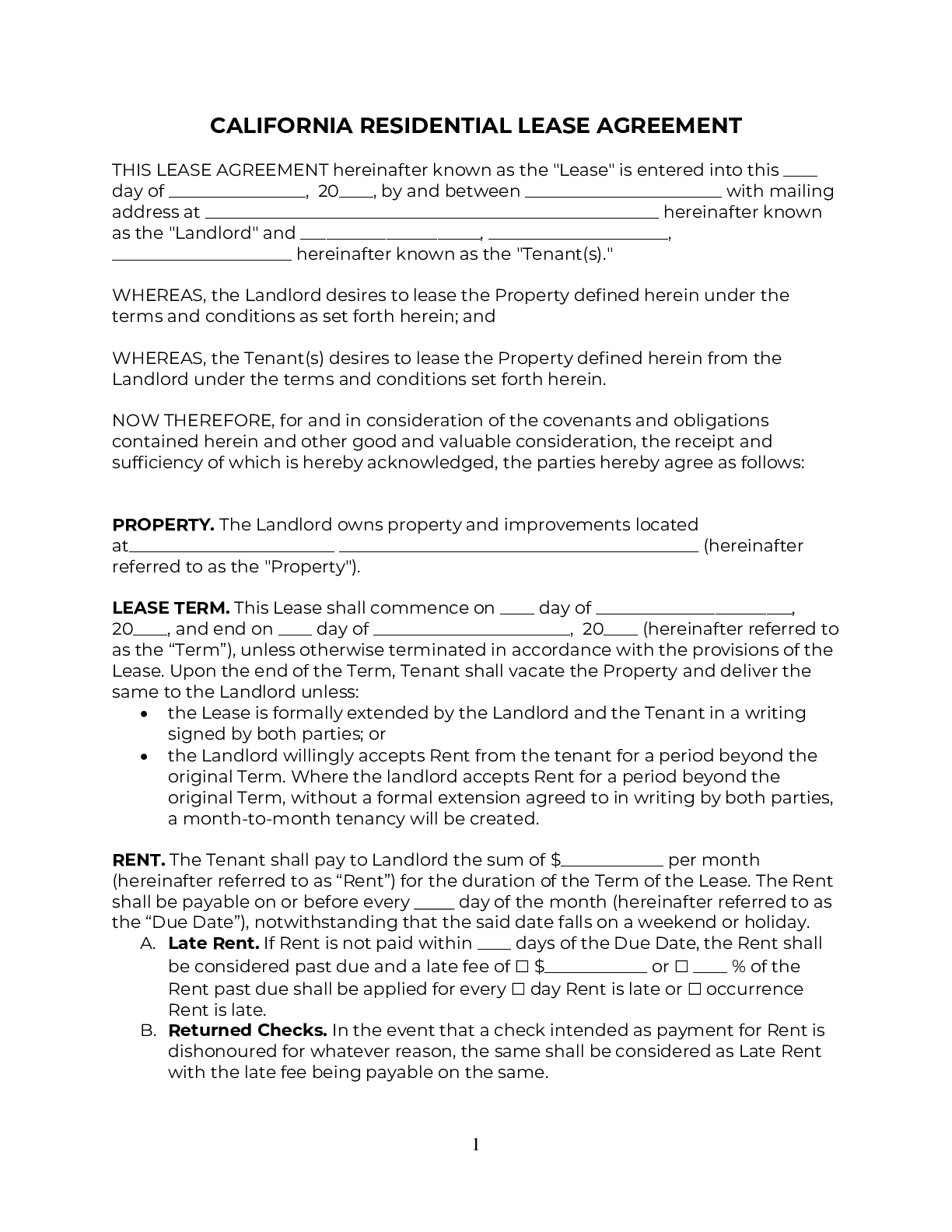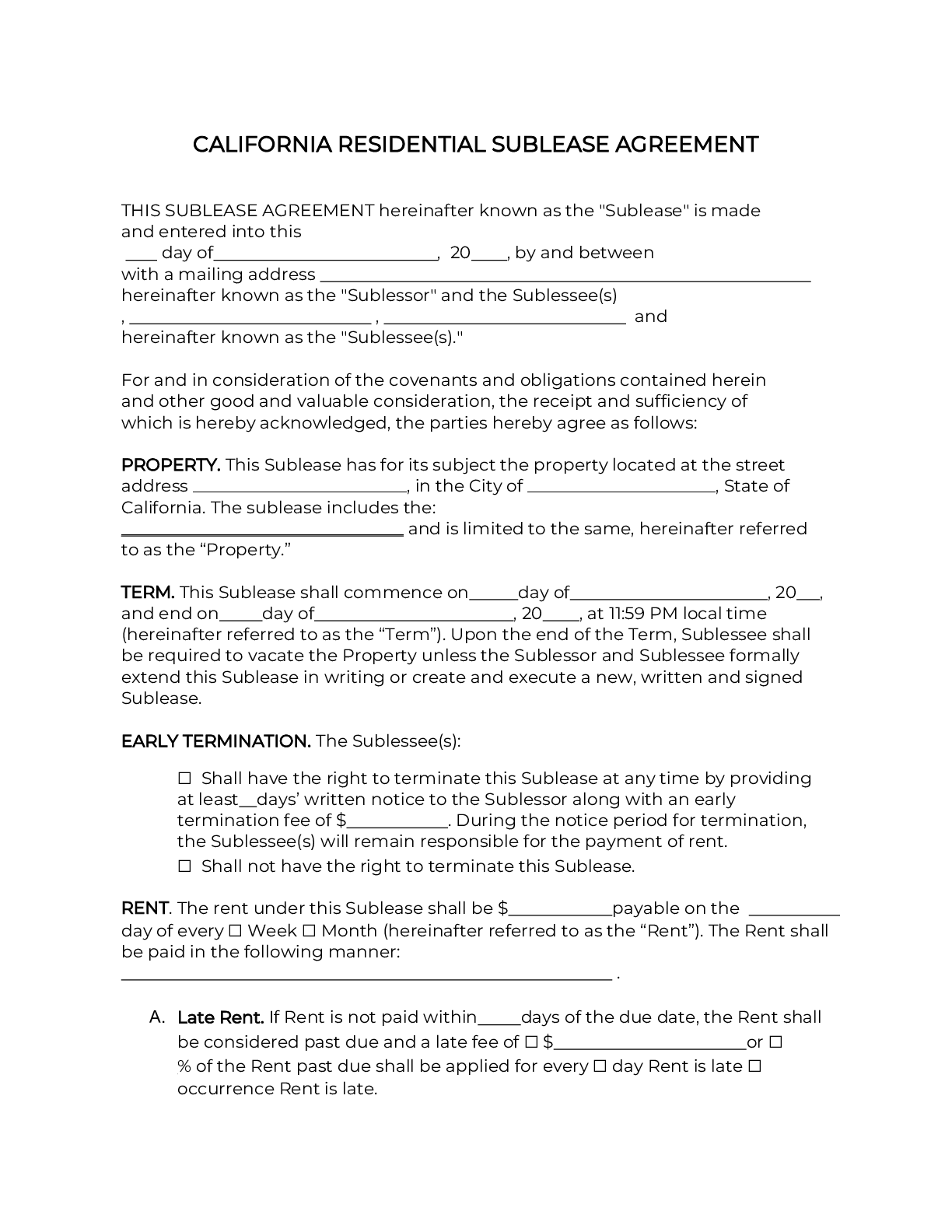California Rental Agreement

A California rental agreement is a legal contract between a landlord of a rental property and a tenant who wishes to use it. A rental agreement describes the terms and conditions for using the property, as well as the amount of rent, and must comply with California’s landlord-tenant laws.
California Rental Agreement Types

A California residential lease agreement (“rental agreement”) is a legal contract for a tenant to rent a residential property from a landlord, subject to terms and conditions agreed by all parties.

A California month-to-month lease agreement is a contract (not necessarily written) where a tenant rents property from a landlord. The full rental term is one month, renewable on a month-to-month basis.

California landlords may use a rental application form to screen potential tenants. A rental application collects information about rental history, income, and other information that would help the landlord decide whether the applicant is a good fit for the property and rental terms.

A California sublease agreement is a legal contract where the tenant of a rental property (“sublessor”) rents the property to a new tenant (“sublessee”), usually with the landlord’s permission.

A California roommate agreement (“room rental agreement”) is a legal contract between two or more people (“co-tenants”) who share a rental property according to rules they set, including for things like splitting the rent. This agreement binds the co-tenants living together, and doesn’t include the landlord.

A California commercial lease agreement is a contract arranging the rental of a commercial space to a business.
Common Rental Agreements in California
California Association of Realtors Residential Lease/Month-to-Month Rental Agreement – Members of the California Association of Realtors (CAA) use this residential lease or month-to-month rental agreement template. It details many rules and procedures, including return of security deposits and reporting of maintenance needs.
California Required Lease Disclosures
- Methamphetamine Contamination Disclosure(required for some leases) – California landlords must disclose potential methamphetamine contamination in the rental unit, unless they have documented safe levels of 1.5 μg/100 cm2 after remediation.
- Mold Disclosure(required for some leases) – California landlords must disclose any knowledge of potential toxic mold in the rental unit.
- Sex Offender Registry Notice(required for all leases) – California law requires that every lease include a notice stating the sex offender registry is available for access on the Department of Justice’s website.
- Demolition Permit Disclosure(required for some leases) – California landlords must provide notice about the date of any upcoming planned demolition in the lease, so tenants know when their lease will end.
- Military Ordnance Disclosure(required for some leases) – California rental properties within one mile of retired ordnance storage or military training grounds must alert potential renters to this fact in the lease.
- Death in a Rental Unit Disclosure(required for some leases) – Unless due to HIV/AIDS, California landlords must disclose all deaths in the rental unit within the last three years before the lease begins.
- Pest Control Disclosure(required for some leases) – California landlords must describe any regular pest control treatments in the lease. They must also provide notice of their right to displace a tenant for 24 hours to perform pest control, so tenants can plan to vacate the premises during scheduled treatments.
- Shared Utility Arrangement Disclosure(required for some leases) – When California buildings share a master meter, the landlord must disclose how utility charges are allocated between each party, to help avoid billing disputes.
- Bed Bug Disclosure(required for all leases) – California landlords must include a bed bug addendum and/or disclosure in every lease agreement to inform prospective tenants about infestation treatment procedures.
- Flood Zone Disclosure(required for some leases) – California properties which fall within a flood zone require disclosure of the hazard before signing a lease. The notice must have a minimum 8-point font and detail the flood zone, resources for learning more, and a recommendation for flood and renters’ insurance.
- Lead-Based Paint Disclosure(required for some leases) – Federal law requires that California leases disclose the dangers of lead-based paint in every property built before 1978, alongside records of any known lead hazards in the rental unit.
To learn more about required disclosures in California, click here.
City-Specific Lease Templates
Many cities in California have specific required and recommended disclosures. Here are major cities with residential lease agreements that differ from the state template:
California Landlord Tenant Laws
- Warranty of Habitability – California landlords must provide a variety of features and amenities on rental property, such as hot and cold running water, smoke detectors, and garbage containers. Tenants may repair and deduct, or withhold rent, if the landlord doesn’t make necessary repairs within 30 days of proper notice.
- Evictions – California landlords may evict for failure to pay rent, lease violations, holding over after a proper lease termination, or illegal activity. Typically, the eviction process can be completed in a week to a few months. However, California properties covered by the CARES Act may be federally entitled to a minimum 30 days of advance notice before a landlord can file eviction for nonpayment of rent or fees, which can extend the eviction process. [1]
- Security Deposits – California landlords may charge up to 2 months’ rent (unfurnished properties) or 3 months’ rent (furnished properties) as a security deposit. When a lease ends, the landlord must return remaining security deposit funds within 21 days after move-out.
- Lease Termination – In California, month-to-month leases can be terminated with 30 days of prior notice (seven days, for week-to-week tenants). Tenants can break a fixed-term lease early without penalty via one of many legally allowed conditions, like an early termination clause, active military relocation, habitability violation, domestic violence, landlord harassment, etc.
- Rent Increases and Fees – California has a statewide rent control system, and local jurisdictions may also maintain their own such systems. These limit the amount of a rent increase and regulate advance notice before an increase. On the other hand, California landlords may charge any type or amount of fees they desire, so long as it is “reasonable.” There’s an exception for a first-time bounced check fee, capped at $25.
- Landlord Entry – California landlords may enter a rented unit between the hours of 8:00 AM and 5:00 PM on weekdays, after providing 24 hours of advance notice. Emergency situations temporarily suspend notice and permission requirements.
- Settling Legal Disputes – California landlords and tenants may settle disputes valued up to $10,000, other than eviction, in the state’s small claims courts. California limits landlords to filing only 2 cases valued at $2,500 or more per year.
To learn more about landlord tenant laws in California, click here.
Sources
Properties and tenancies that are covered under the CARES ACT must be provided 30 days’ notice to vacate for non-payment of rent.
Caution: There is not yet any statewide judicial guidance in California regarding the CARES Act requirements. As noted above, the City of Alameda officially states a 30-day notice is required for nonpayment of rent or other fees. An Alameda court case from June 2024 confirms this. While not an official resource, California Association of Realtors guidance from May 2023 agrees that the law appears to require a 30-day notice to evict for nonpayment of rent or other fees, in properties covered by the CARES Act.








